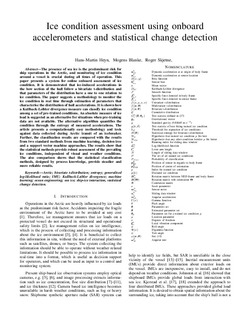| dc.contributor.author | Heyn, Hans-Martin | |
| dc.contributor.author | Blanke, Mogens | |
| dc.contributor.author | Skjetne, Roger | |
| dc.date.accessioned | 2020-02-04T11:10:55Z | |
| dc.date.available | 2020-02-04T11:10:55Z | |
| dc.date.created | 2020-01-18T19:38:05Z | |
| dc.date.issued | 2019 | |
| dc.identifier.citation | IEEE Journal of Oceanic Engineering. 2019, . | nb_NO |
| dc.identifier.issn | 0364-9059 | |
| dc.identifier.uri | http://hdl.handle.net/11250/2639517 | |
| dc.description.abstract | The presence of sea ice is the predominant risk for ship operations in the Arctic, and monitoring of ice condition around a vessel is crucial during all times of operation. This paper presents a system for online onboard assessment of ice condition. It is demonstrated that ice-induced accelerations in the bow section of the hull follow a bivariate t-distribution and parameters of the distribution have a one-to-one relation to ice condition. This paper suggests a methodology to monitor the ice condition in real time through estimation of parameters that characterize the distribution of hull accelerations. It is shown how a Kullback–Leibler divergence measure can classify ice condition among a set of pretrained conditions. An absolute measure of ice load is suggested as an alternative for situations when pretraining data are not available. The alternative algorithm quantifies the condition through the entropy of measured accelerations. This paper presents a computationally easy methodology and tests against data collected during Arctic transit of an icebreaker. Furthermore, the classification results are compared with the results from two standard methods from machine learning, decision tree and a support vector machine approaches. The results show that the statistical methods provide robust assessment of the prevailing ice conditions, independent of visual and weather conditions. Also, the comparison shows that the statistical classification methods, designed by process knowledge, provide steadier and more reliable results. | nb_NO |
| dc.language.iso | eng | nb_NO |
| dc.publisher | Institute of Electrical and Electronics Engineers (IEEE) | nb_NO |
| dc.relation.uri | https://ieeexplore.ieee.org/document/8661747 | |
| dc.subject | Marin kybernetikk | nb_NO |
| dc.subject | Marine cybernetics | nb_NO |
| dc.subject | Isforvaltning | nb_NO |
| dc.subject | Ice Management | nb_NO |
| dc.subject | Arktisk teknologi | nb_NO |
| dc.subject | Arctic Technology | nb_NO |
| dc.title | Ice condition assessment using onboard accelerometers and statistical change detection | nb_NO |
| dc.type | Journal article | nb_NO |
| dc.type | Peer reviewed | nb_NO |
| dc.description.version | acceptedVersion | nb_NO |
| dc.subject.nsi | VDP::Skipsteknologi: 582 | nb_NO |
| dc.subject.nsi | VDP::Ship technology: 582 | nb_NO |
| dc.source.pagenumber | 17 | nb_NO |
| dc.source.journal | IEEE Journal of Oceanic Engineering | nb_NO |
| dc.identifier.doi | 10.1109/JOE.2019.2899473 | |
| dc.identifier.cristin | 1776530 | |
| dc.relation.project | Norges forskningsråd: 223254 | nb_NO |
| dc.relation.project | Norges forskningsråd: 203471 | nb_NO |
| dc.description.localcode | © 2019 IEEE. Personal use of this material is permitted. Permission from IEEE must be obtained for all other uses, in any current or future media, including reprinting/republishing this material for advertising or promotional purposes, creating new collective works, for resale or redistribution to servers or lists, or reuse of any copyrighted component of this work in other works. | nb_NO |
| cristin.unitcode | 194,64,20,0 | |
| cristin.unitname | Institutt for marin teknikk | |
| cristin.ispublished | true | |
| cristin.fulltext | postprint | |
| cristin.qualitycode | 1 | |
